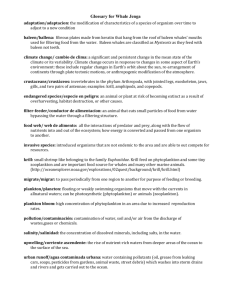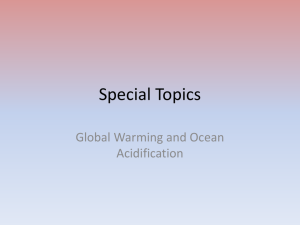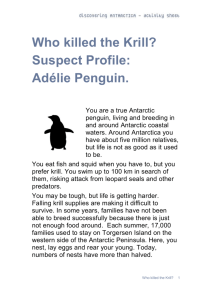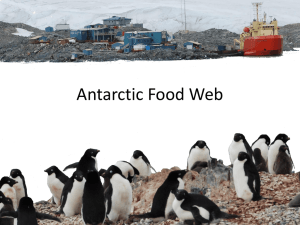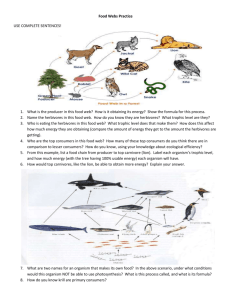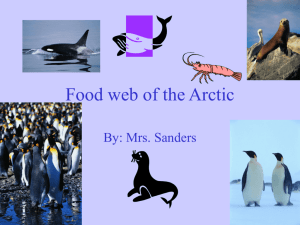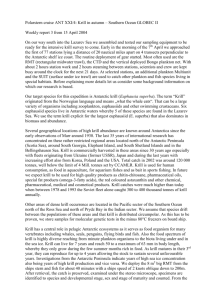Antarktis
advertisement
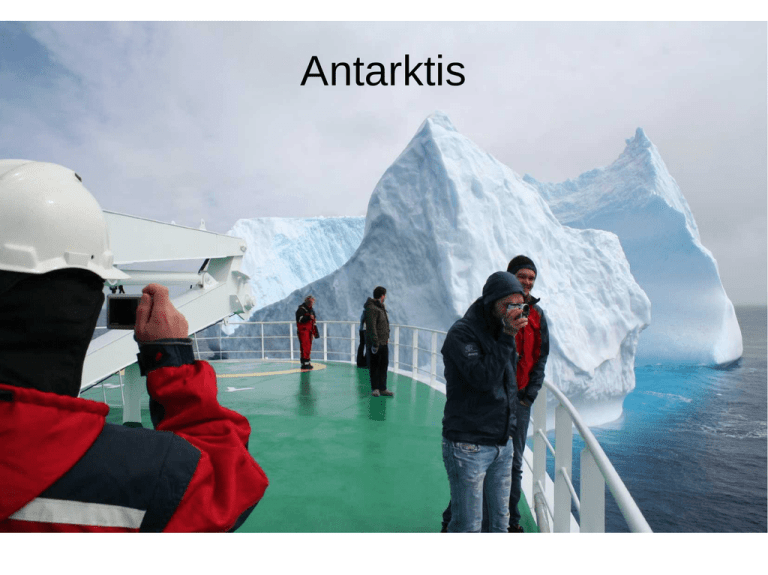
Antarktis Antarktis: Major currents - Area partially separated from other areas by the hydrographical features Depths: Hydrography Deep ocean circulation Ice and bottom water masses - Polynyas - Sea-ice formation (brine) => dense, i.e. Saline and cold watermasses Transport: - Watermasses in clockwise rotation - Several frontal zones Frontal systems - Polar front - ACC - Antarctic Circumpolar Current Peninsula/Scotia Sea/South Georgia - One of the best studied areas of the Antarctic (USA & UK) - High krill biomass Frontal zones around SG - Drake passage - Topographical forcing - Weddel sea gyre Other well studied areas: - Antarctic peninsula - Ross sea - quite different biology, other groups more important - 0-meridian - Indian ocean sector Primary production and HNLC - Seasonally high light levels - High levels of nutrients - Low production - HNLC paradox Iron limitation - Iron hypothesized as the main limiting factor - High patchiness - Production highest downstream of iron-sources Iron enrichment - Mesoscale experiments suggests iron limiting - But uncertain whether increase in prod. Transl. to increased export - Suggested as mechanism to combat global warming - Commercial operators already selling CO2-quotas based on marine iron-enrichment Sea ice and seasonality: Sea ice as a habitat: - “Separate” food-chains associated with the sea-ice, i.e. with specialised flora and fauna. - Sympagic: A sympagic environment is one where water exists mostly as a solid, ice - Ice habitat also extremely important to more generalist species like E. superba, and important for spring blooms Food webs: - Perceived as extremely simple - As usual a bit more complex, but this gives a reasonable picture of energyflow in some antarctic pelagic ecosystems Antarctic krill - Often used synonymously with E. superba - E. superba relatively longlived (up to at least 7 yrs), though only few attain this age. - Maturity at 2-3 yrs - Up to approx. 6 cm - E. superba P/B ratio approx. 1 Antarctic krill - Spawning in upper 100 m - Clutch size 6.000-10.000 eggs, several clutches - Spawning late spring and summer, mainly from early January to mid February - Eggs negatively bouyant, hatch from 500-2000m depth - Note: eggs that hit bottom prob. lost Antarctic krill - Center of spawning around the Peninsula - Eggs and larvae mature on the “conveyor belt” - Stock at South Georgia perceived as “sink” - Separate stock in Weddel Sea? 5 minutter krilltråling i Antarktis. Bilder Einar Loshamn Fangst ca. 2 tonn. Bilder Einar Loshamn, men foreleser var faktisk tilstede Krill behaviour - Adults relatively strong swimmers (12-20 cm/s sustained) - High escape speeds (1 m/s) - Capability to utilise ice-algae, using legs to scrape algae from ice - Ice especially important for young krill - Species primarily herbivorous (i.e. uses filter basket) - Species found mainly above 250 meters, especially during summer Antarctic krill, behavior: - Some describe the species as a obligate swarmer - High proportion of biomass found in swarms - Purpose of swarming? Krill behaviour: - Swarm densities exceeding 1000 ind/m3 reported - Swarming/Schooling: - Antipredator behaviour -dilution of risk -more eyes open -effective against some predators (confusion..) -hiding??? - Spawning - Feeding - Migration Krill biomass - Centered in the Atlantic sector (Figure from Atkinson et al. In press) Other important groups: - Salps - may dominate in some years and regions - Copepods - biomass generally dwarfed by krill, but around SG biomass approx. 1/1 Salps - Colonial chordates - Filterfeeders - Houses may clog at too high dens. of large phyto Amphipods - Themisto shallow - Lots of other species in deeper waters Gigantocypris sp. Bilder Einar Loshamn Predators: - Mainly air-breathing predators known to be important, especially seals and penguins, but this may be because this is the only group we've got numbers for - Pelagic and benthopelagic fish stocks - Whales Seals - Crabeater seals krill specialists - Krill also appear in the diets of other species, especially fur seals - Seal populations exploded after the commercial whaling began, and was also exploited commercially even prior to commercial whaling Important seal species - Fur seal - Elephant seal - Crabeater seal - Leopard seal Antarctic fur seal - Major krill predator - Population exploded after whales hunted, but this species was also commercially exploited Lobodon carcinophaga, Krabbeetersel Hunner: 2.2-2.6m, 220kg. Hanner noe mindre. Ved fødselen: 1.2 m, 30kg. Verdens mest tallrike selart: trolig mer enn 15 millioner individer. (Bestandsestimat på inntil 50 millioner har vært publisert.) Tenner velegnet til å filtrere krill fra vannet. Opptrer i familiegrupper. Hydrurga leptonyx, Leopardsel Hanner: 2.5-3.2m, 200-455kg. Hunner: 2.4-3.4m, 225-591kg. Ved fødselen: 1.5-1.6m, 35kg. Pakkis rundt hele kontinentet og øyene. Bestand ca 220,000 – 400,000. Spiser andre sel, pingviner, blekksprut og krill. Slekten Mirounga Elefantseler Mirounga angustirostris Nordlig elefantsel Mirounga leonina Sørlig elefantsel Hanner: 4.5m, 2,300kg. Hunner: 3.6m , 750kg. Ved fødsel: 1.5m, 30kg. ASM: Hunner 3-5 år, hanner 4-6 år, sosialt 9-12 år. Bestand: 84,000 i US California, 32,000 i Mexico. Hanner: 4,2 m, 2,200kg. Hunner: 2,7m, 500kg. Ved fødsel: 1.3m, 50kg. ASM Hunner 2-4 år, hanner: 3-6 år (sosialt 10 år). Bestand: 600,000. Dykkedybde 2km, dykktid 2 timer Begge arter sterkt overbeskattet historisk. Nordlig var nesten helt utryddet, og det var mindre enn 100 individer igjen på den fjerntliggende mexicanske øya Guadalupe da fangsten stoppet på slutten av 1800-tallet Whales - Several of the whale stocks have rebounded in the later years, though not all. We saw only humpbacks -Despite this, whale populations are much lower than before whaling started - Many species follows ice-edge - Krill biomass the main force behind feeding excursions to the Antarctic Baleen whale species in the Antarctic * Blue whale * Minke whale * Humpback whale * Fin whale * Southern right whale * Pygmy right whale Humpback whale Nordkaper Whaling - Krill surplus theory Først den ene, så den andre,… 30000 25000 Knølhval Blåhval Finnhval Seihval Sperm Vågehval 20000 15000 10000 5000 0 1910 1930 1950 1970 1990 Statistikken • I perioden 1910 - 1990 ble det tatt • • • • • • 103 000 knølhval 344 000 blåhval 694 000 finnhval 132 000 seihval 198 000 spermhval 118 000 vågehval Penguins and other birds - Chinstrap and macaroni penguins major consumers of krill - Prions and fulmars also dependent on krill - Limited travel possibilites during breeding season gives strong spatial variation in krill predation Important avian species Important avian species - In addition to penguins, also flying species: - Petrels - Albatross species Fish and squid - Unknown importance, biomass unknown, but krill important in the diet of many species Important fish groups - Icefish - Lack haemoglobin - Mostly neritic/demersal Mesopelagic fish Antarctic food webs: - Few levels, high trophic efficiencies - Krill in a central position Ross sea ecosystem Salps and krill Salps and krill - Krill biomass correlated with winter ice extent and duration - Mechanism: young krill dependent on ice-algae for survival? - Salps and krill biomass inversely related Salps, krill and sea ice: - Salps and krill biomass inversely related - Krill population recruitment dependent on sea ice - Krill reproduce near Peninsula - Peninsula area among the most affected by global warming - Krill/salp mechanism not fully understood - Ice con Predation in the Scotia Sea - Krill the most important food by weight - Spatial variation, and these numbers refer to Scotia sea ecosystem. - E. superba less important in Ross Sea Predation in the Scotia Sea - Fish/squid consumption unknown - The known biggest consumers penguins and seals - Whales comparatively low - Air breathing predators with rearing of young on land => high spatial variation in predation Antarctic krill: - Several species - Most important: Euphausia superba - Other common species include E. triacantha, E. frigida, E. crystallorophias and Thysanoessa species. - Dominant in biomass in the Antarctic zone - Biomass Atlantic sector: 37 – 200 mill tons - Catch limit: 4.7 mill tons - Current catches: 100-200MT Products of Antarctic krill - Aquaculture feed (e.g. protein) - «Marine» oils (health products) - Human food! - Pigment for aquaculture But high fluoride values in antarctic krill! Other fisheries: - Toothfish (line fisheries) - Mackerel icefish Problems of commercial catches - Technical (quickly deteriorating, high fluoride etc) - Ecological/ethical (fishing down the food web, interference/overlap with central place foragers etc, slow growth in polar waters) Paradigms? Current paradigm, based on pel. studies since ca. 1980: - System controlled by primary production, i.e. Bottom up - Air-breathing predators the main top-down ”force” - What about squid/fish? Will whales affect ecosystem structure? - How about sea ice? - Increasingly clear that there is no «Antarctic ecosystem», but several ecosystems
